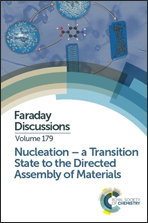Amorphous calcium phosphate phase-mediated crystal nucleation kinetics and pathway†
Abstract
Generally, a solution nucleation model is used to study biomineralization kinetics. However, we found that the amorphous calcium phosphate (ACP)-mediated hydroxyapatite (HAP) nucleation in simulated body fluids (SBF) had a different profile from the linear relationship between ln J and ln−2 S (J, nucleation rate; S, supersaturation). This behaviour was alternatively explained by a developed heterogeneous nucleation theory, which indicated that HAP was nucleated at the ACP–solution interface via a polymorph transformation. Based upon this new model, we demonstrated experimentally that the embedded polymer molecules inside ACP were inert on HAP nucleation kinetics; rather, the polymers adsorbed on ACP surface could inhibit HAP nucleation from ACP. It further confirmed the heterogeneous nucleation pathway of HAP on the precursor phase. The present study provides an in-depth understanding of HAP formation for ACP-mediated crystallization.
- This article is part of the themed collection: Nucleation – a Transition State to the Directed Assembly of Materials

 Please wait while we load your content...
Please wait while we load your content...